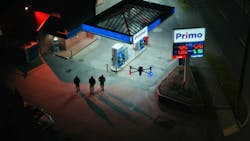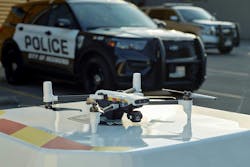What to Know
- Motorola Solutions and BRINC are collaborating to integrate drone technology.
- BRINC’s purpose-built, American-made drones feature payloads, voice, lights, and sirens, offering unique solutions for law enforcement and fire departments.
- The partnership aims to expand drone programs across thousands of police and fire stations, with a focus on next-generation product development and technology integration.
- Recent regulatory changes, such as BVLOS waivers, have significantly accelerated the deployment of drones in emergency situations.
More on OFFICER.com
Download the July/August issue of OFFICER Magazine.
Click Here to subscribe to OFFICER Magazine.
As some states have begun to bar law enforcement agencies from using Chinese-made drones, more U.S.-based companies are stepping in to fill the void and offer an alternative. This past spring, Motorola Solutions announced a strategic alliance with one of those companies: Seattle-based drone manufacturer BRINC. The new partnership aims to integrate the five-year-old company’s Drone as First Responder (DFR) solution, the Responder drone and the Responder Station charging dock, with Motorola’s CommandCentral Aware, APX radios, VESTA 911, Computer-Aided Dispatch systems and Automatic License Plate Recognition technology.
According to Motorola Solutions, more than 60% of North America’s public safety answering points (PSAP) rely on CommandCentral Aware, the company’s Real-Time Crime Center software. The company believes the strategic alliance with BRINC will make it easier for public safety agencies to introduce drones and DFR programs.
“With over 240 million 911 calls made each year, a faster response time to the call can be the consequential difference in an emergency,” Mahesh Saptharishi, executive vice president and chief technology officer with Motorola Solutions said in a statement following the announcement. “We’re integrating the powerful capabilities of drones into 911 software, enabling precious time saved to deliver that life-saving medicine or give officers eyes and ears on scene before they arrive.”
A beneficial partnership
During the Motorola Summit 2025 in Grapevine, Texas, in May, OFFICER Magazine spoke to Blake Resnick, Founder and CEO of BRINC, and Jeremiah Nelson, CVP of Product & Technology at Motorola Solutions, about how the strategic alliance will help both companies expand their footprint when it comes to public safety drones.
“I’ve been talking to Motorola for a couple of years about various ways that we can work together. Everything just fell into place within the last six months to a year. I couldn’t be more excited about the distribution element of it—we’re working together to meet with agencies. But also, technology integration by deeply connecting computer aided dispatch and Real Time Crime Center software with Command Central Aware,” says Resnick, who added that currently about 700 public safety agencies are currently working with BRINC on implementing DFR programs.
Resnick also pointed out that as part of the technology integration, 911 call handlers will be able to dispatch BRINC’s Responder drones from docking stations in response to emergency calls with the push of a button from Motorola Solutions APX NEXT smart radios. BRINC’s own software solution, LiveOps, also will be integrated into CommandCentral Aware to help track the drones.
Nelson says that Motorola Solutions wanted to partner with a U.S.-based drone company, and that it was intrigued with what BRINC brought to the table. “BRINC is bringing a purpose-built American-made, vertically integrated solution to market. It’s very different from how all the companies have been solving DFR to date,” he says.
He noted that Motorola Solutions has been involved with DFR since day one when the Chula Vista Police Department in California launched its DFR program using the company’s CAPE software solution back in 2018. “We’re really proud of what we’ve done with CAPE. If you want to have a mixed fleet of drones, and you already have drones that you want to connect up to our software, we can provide that,” he says. “This new paradigm that BRINC is bringing is incredibly compelling. There’s the drone that they’ve built, nobody has anything else like it. The payloads, the voice, the lights and sirens. Nobody is solving for this market in that way. We’re really proud to make the investment in BRINC and have them as a partner.”
Growing acceptance and adoption of DFR
As department policies and state and federal laws have started to catch up to DFR technology, Resnick says more law enforcement agencies are turning the corner when it comes to adding drones for emergency response. “I think the value proposition is so compelling that agencies are universally excited. Sixty-second 911 call response times, clearing out calls for service with drones alone like low priority calls,” he says, referring to calls for a suspicious person who isn’t suspicious or an obstructed roadway that is cleared by a civilian. “In all those cases with DFR, public safety is able to realize maybe this call doesn’t require a response from officers, and then they can redirect that asset towards a higher critical emergency. For a lot of departments that are struggling with staffing, that is an amazing thing to be able to offer them. There also are safety advantages of having a live drone video feed of every situation officers walk into.”
When it comes to expanding DFR programs across the country, Resnick stresses that currently there is a lot of room for growth. “The way I think about it is, there are roughly 20,000 police departments in America, roughly 30,000 fire departments and about 80,000 police and fire stations. But less than 100 have drone recharging stations on the roof to send drones to respond to 911 calls,” he says. “I think in the future though, maybe 50% of those 80,000 buildings will have this capability. It’s all about expanding that number. We’ll do that through next generation product development, but also through meeting with additional agencies and by integrating with all the existing that technology they already use.”
Another key factor driving growth of DFR programs is Beyond Visual Line of Sight (BVLOS) waivers. BVLOS waivers, granted by the Federal Aviation Administration, allow public safety agencies to operate drones beyond the pilot’s direct line of sight during emergency situations.
“We’re finding our customers are getting BVLOS waivers, roughly in two weeks now,” Resnick says. “It’s far faster than it ever has been. It’s difficult to overstate how much that’s changed. Especially in the last six months.”
Nelson agrees that recent changes have driven growth in the marketplace. “We’ve been leading this market the whole time quietly, but it’s been an ecosystem of drones to hook up to the CAPE software. That was based really on the way the budgets worked. Before Beyond Visual Line of Sight, you had somebody looking at a drone. You were paying a pilot’s salary up on the roof. You were spending more on people and less on hardware,” he says. “With BVLOS, the ratio of people to drones changes pretty dramatically. If you already had a budget, that ratio of human capital to technology changes, and you have more budget freeing up to buy a different price point of drone with a different set of capabilities. You have BRINC coming to answer that with the purpose-built, American-made drone. With the change in the waivers, just in the last six months, it’s been dramatic. DFR is happening now.”
About the Author
Paul Peluso
Editor
Paul Peluso is the Managing Editor of OFFICER Magazine and has been with the Officer Media Group since 2006. He began as an Associate Editor, writing and editing content for Officer.com. Previously, Paul worked as a reporter for several newspapers in the suburbs of Baltimore, MD.



